





|
Hasiera · Home |
|
Ezaugarriak · Features |
|
Oharrak · Notes |
|
Sarrera · Introduction |
|
Euskara |
|
Folklore |
|
Kirolak · Sports |
|
Musika · Music |
|
Janedanak · Gastronomy |
|
Tokiak · Places |
|
Historia · History |
|
Politika · Politics |
|
Diaspora |
|
Internet |
|
Albisteak · News |
|
Nahas Mahas · Misc |

For security reasons, user contributed notes have been disabled.
by David Cox
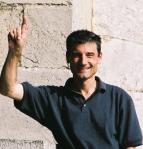 David Cox is employed as a writer and editor and lives in Ontario, Canada. David also contributes review articles to the U.S -based internet publications rambles.net and rootsworld.com, where he writes about European world-roots music, specializing in the music of Euskal Herria and Cymru-Wales. His hobbies include studying the Basque and Welsh languages and playing Euskopoli with his children. David Cox is employed as a writer and editor and lives in Ontario, Canada. David also contributes review articles to the U.S -based internet publications rambles.net and rootsworld.com, where he writes about European world-roots music, specializing in the music of Euskal Herria and Cymru-Wales. His hobbies include studying the Basque and Welsh languages and playing Euskopoli with his children.
|
Basque music is, of course, thousands of years old. Euskal Herria -- the Basque Country -- notably for its small population, can boast many composers of world importance. Many Basque composers were forced to work in Madrid, Paris and elsewhere, but others were able to work and teach for long periods closer to home. The greatest of all Basque composers never forgot, despite their travels, their attachment to their Basque homeland.
There are a number of composers from the Middle Ages and Renaissance whose names and work is known to us today. Juan de Anchieta (Azpeitia, 1462-1523) composed various masses, motets, magnificats and other sacred music. He was likely educated in Iruñea-Pamplona, and appeared in 1489 in the court of Isabella of Castile. He also lived in Flanders but returned to live in Azpeitia a few years before his death.
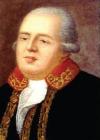 |
| Javier Maria de Munibe Idiáquez |
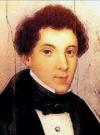 |
| Juan Crisótomo de Arriaga |
At age 13, Arriaga wrote an opera, Los esclavos felices, successfully produced in Bilbao, of which the overture survives. His Symphony in D, and three string quartets, written at the age of eighteen, were published during his lifetime. He also composed a second opera (Nada y Mucho), church music, and cantatas. Arriaga's music can be compared to the best work of the time. Those who have visited Bilbao will know of the impressive concert hall that bears his name.
Close behind chronologically were others including Sebastián de Iradier (Yradier) y Salaverri (Lantziego, Araba, 1809-1865). He began his career in Madrid, writing zarzuelas, habaneras, including La Paloma and El Arreglito, later incorporated by Bizet in his opera Carmen.
The late 19th century, and early 20th, was a time of great musical change throughout Europe and Basque composers distinguished themselves. Romantic nationalism and a sense of place were reflected in music. Countries which did not exist independently at the time (Czech Republic, Finland, Norway) found national expression in the works of such composers. This was as true in the Basque Country as anywhere.
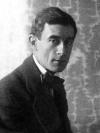 |
| Maurice Ravel |
Ravel, best known for his Bolero, intended to write a concerto, Zazpiak Bat (The Seven are One) reflecting his Basque heritage. Surviving notes and fragments confirm that this work was to be influenced by Basque music. While Ravel did not complete the piece, he used its themes and rhythms in some of his other works.
While Ravel's many accomplishments have been amply chronicled elsewhere, his Concerto for Left Hand, (written for the pianist Paul Wittgenstein, who continued his piano career after a war injury deprived him of his right), is an incredible accomplishment. As for Ravel, if he is often considered a French composer, it is worth noting that he was also a Basque, who never lost the ability to speak his first language, Euskara.
In the Southern Basque Country, Beltrán Pagola Goya (Donostia, 1878-1950) is influential as teacher of the greats Sorozabal, Garbizu, Usandizaga and Escudero. He was professor in the Conservatorio in Donostia for 50 years, founding the Orquesta Sinfónica there and writing Tratado práctico de armonía. He helped to oversee a tremendous period of growth in Basque musical composition, corresponding with the rise of a middle class in Bizkaia and Gipuzkoa.
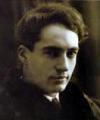 |
| Andrés Isasi y Linares |
Isasi studied with Humperdinck in Berlin, returning to Bilbao in 1914. He lived quietly in Getxo composing music and supporting Basque artists, and died in obscurity. His romanticism has much in common with German composers of the same period, perhaps too German for the Basque audiences of the day. His style has been compared to Grieg, Tchaikovsky, Bruch and Korngold. His works include Berceuse Tragica, a work for violin and orchestra.
Isasi's Second Symphony, which was compared to Strauss or Scriabin, was first heard in Budapest in 1931. This is among the works of Isasi which seem to be enjoying a revival in popularity today.
By contrast with Isasi, Arámbarri incorporated a more 'Iberian' sound and has been compared to the Catalan prodigy Albéniz, among others. Arámbarri composed some of his most important works as a student in Paris and Basel. His Orchestral Prelude was based on three Basque folk songs. Eight Basque Songs is another of his notable compositions.
After his return to Bilbao he was primarily a conductor and is better known as director of the Bilbao Symphony Orchestra than as a composer.
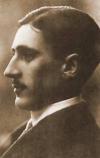 |
| José María Usandizaga Soraluce |
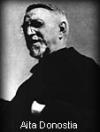 |
| Aita Donostia |
Aita Donostia is associated with the town of Lecaroz, in Navarra, where he lived and studied off an on for half a century. He also lived in France (during a post-Civil War exile) and Barcelona. After his studies in Navarra and Barcelona, he learned Euskara as an adult while studying Basque music.
His beautiful Basque Preludes, a key work, was an extremely important series of such studies arranged for piano. These were originally pieces for piano, based on Basque folk tunes, and later orchestrated. These include Oyanian, Eztei-taldea, Seask'aldean and Urruti Jaia. The Basque Watercolours (Acuarellas Vascas), written in 1932, incorporated many ideas of French impressionism under the influence of Debussy, Ravel and Fauré.
He wrote both sacred music and music with a Basque theme. Both were incorporated in a choral piece called the Mirandola Ironworkers, based on a legend about ironworkers from Legazpi who worked on the Sabbath, returning the next day to find an impressive iron cross they couldn't possibly have built in one day. Aita Donostia's achievement was to bring to light the already-existing wealth of Basque folk music and lend it the prestige of an 'educated' treatment.
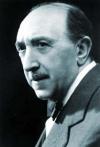 |
| Jesús Guridi Bidaola |
El Caserio (1926) is one of the best known of his zarzuelas. It takes place in a fictional Bizkaian village called Arrigorri. Although this beautiful opera was written and sung in Spanish, two earlier operatic works written and performed in Basque, Mirentxu (1910) and Amaya (1920) were of great importance to the development of Basque music and culture.
Although he had moved to Madrid, his beautiful Diez melodías vascas written in 1941, was another profound testament to his attachment to Euskal Herria, a 22-minute suite of impressionist Basque folk-melodies.
Guridi never lost touch with his Basque roots. As testified by his son, Guridi "was an upright Basque, filled with the spirit and vitality of his people ... capturing the sounds of a flowing river, the majesty of a mountain, the rustling of trees, or of a wandering txistu."
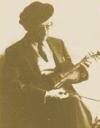 |
| Pablo Sorozabal Mariezkurrena |
Like Isasi, his music was influenced by study in Germany. Like Guridi, Sorozabal wrote a great deal of music reflecting his Basque origins -- music that has great importance in the Basque Country today. Specifically, his powerful funeral march for choir and orchestra, Gernika, his favourite work, is significant for many Basques.
His works also include the choral Suite vasca (1923); Dos apuntes Vascos (1925) and Symphonic Variations on a Basque Theme (1927), produced in Germany. Two short choir and orchestra pieces, Maite, and ¡Ay, tierra vasca! also express Basque themes. His popular zarzuelas include Katiuska, (featured in 2008 in Donostia's Kursaal) and Adios a la Bohemia (with libretto by Pio Baroja) in the mid-30s. Later, though, because of his politics, Sorozabal's zarzuelas weren't often produced in major Madrid venues.
Sorozabal regretted his inability to speak the Euskara of his childhood: "because of the pressures of life and a centralised government policy we were forced to forget our language. I am ashamed of this and still hope, even if only at the end, to speak my dying words in the same language I used to express my first feelings."
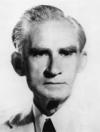 |
| Tomas Garbizu Salaberria |
Garbizu's work includes his Cinco Canciones Vascas. He also wrote a mass dedicated to Pope John XXIII, an Ave Maria for soprano and orchestra, a selection of Basque folk song settings, an orchestral song set to a work by Bangla-language poet Rabindranath Tagore, and a work for harp, organ, and orchestra. His work also includes works for txistu, zarzuelas, tone poems, choral works and songs, taking his inspiration from sources as diverse as Gregorian chant and Basque folk music.
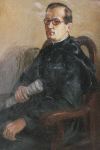 |
| Aita Madina |
His works include a Concierto Vasco for four guitars and orchestra, performed in San Francisco in 1970, and an interesting three-movement Basque Rhapsody. His harmonic arrangement of Aita Gurea is an important one for Basque choirs.
He suffered from serious health issues in his last few years and eventually returned to Onati in 1971 -- where his symphonic poem for choir, Oñati was performed, as was his Aránzazu. Other works include a Basque Christmas Suite, Agur Mari, for orchestra and choir, a Basque Children's Overture for orchestra, and the three-movement Orreaga suite.
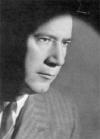 |
| Francisco Escudero Garcia |
Escudero fought for the Basque Nationalists during the Civil War and later was exiled to France. Some of his early works were lost as a result of that war.
Returning later to Bilbao, Escudero -- like Guridi before him -- taught at the Bilbao Choral Society. He later took over from Pagola, teaching in Donostia.
Among his best works are works on a Basque theme: His Basque Concerto of 1946 owes a debt to Ravel. His hour-long funeral oratorio Ileta was written to accompany a poem by Lizardi that ends "bihotzean min dut" ("My heart is broken"). Zigor, an opera on a Basque theme, took six years to write and four years to see performed in Bilbao.
Other works include: Concierto para violoncello y orquesta, Sinfonía sacra, Tonemas for solo piano, Fantasía geosinfónica and the opera Gernika, performed in 1987 for the fiftieth anniversary of the bombardment of that town. Aránzazu (a symphonic poem) was also well received.
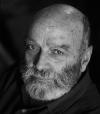 |
| Luis de Pablo |
 |
| Alberto Iglesias Fernández-Berridi |
 |
| Gabriel Erkoreka |
 |
| Ramon Lazkano |
Suggested recordings
Claves (Basque Music Collection) and the more economical Naxos (Spanish Classics) have made the works of a full range of Basque composers available, including many of those named above. Of the Naxos recordings, Jordi Masó's interpretation of Aita Donostia's Preludes stands out.
Besides this, Il Fondamento (Fuga Libera, 2006) has recorded Arriaga's orchestral works on period instruments on a wonderful CD. Elkar's 2-CD Homenaje set of Sorozabal (Coral Andra Mari Abesbata, Orquesta Sinfonica de Madrid, 1997) was produced on his 100th anniversary. Maurice Ravel's work, of course, is widely available. Oldarra's Le Chant Basque features many stunning choral arrangements of Basque songs by these composers.
Suggested Web Sites
www.musikaste.com
List of composers, short biographies, and list of their works: Euskara and Spanish
www.zarzuela.net
Web site on zarzuela and its composers: English
www.naxosdirect.com
Various Basque artists are recorded on this label: English
eu.wikipediea.org/wiki.Euskal_musika_klasikoa
Lists composers with short biographies: Euskara
--- David Cox
|
Please report any problems or suggestions to Blas. Eskerrik asko! |





